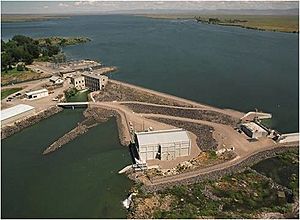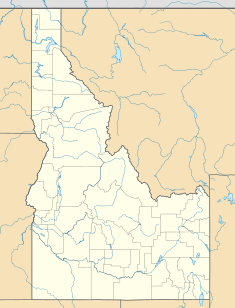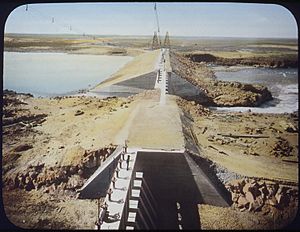Minidoka Dam facts for kids
Quick facts for kids Minidoka Dam |
|
|---|---|

Minidoka Dam and Lake Walcott
|
|
|
Location of Minidoka Dam in Idaho
|
|
| Location | Cassia / Minidoka counties, Idaho, USA |
| Coordinates | 42°40′10″N 113°29′01″W / 42.66944°N 113.48361°W |
| Construction began | 1904 |
| Opening date | 1906 |
| Operator(s) | U.S. Bureau of Reclamation |
| Dam and spillways | |
| Impounds | Snake River |
| Height | 86 feet (26 m) |
| Length | 4,475 feet (1,364 m) |
| Spillway type | Gated and flashboard section |
| Spillway capacity | 40,800 cu ft/s (1,160 m3/s) |
| Reservoir | |
| Creates | Lake Walcott |
| Total capacity | 210,200 acre-feet (0.2593 km3) |
| Catchment area | 2,231 sq mi (5,780 km2) |
| Surface area | 4,245 feet (1,294 m) |
| Power station | |
| Hydraulic head | 74 ft (23 m) |
| Turbines | 2X10 MW Kaplan horizontal turbines (Units 8, 9) 3 and 5.5 MW Francis turbines (Units 6 and 7), Units 1-5 retired |
| Installed capacity | 28 MW |
|
Minidoka Dam and Power Plant
|
|
| Area | 640 acres (260 ha) |
| Built | 1904 |
| NRHP reference No. | 74000746 |
| Added to NRHP | October 29, 1974 |
The Minidoka Dam is a large dam built on the Snake River in southern Idaho. It's an earthfill dam, meaning it's made mostly of earth and rock. The dam was finished in 1906. It stands 86 feet (26 meters) high and stretches almost a mile (1.6 kilometers) long.
The dam helps create Lake Walcott, a popular spot for fun outdoor activities. You can find Lake Walcott State Park and the headquarters for the Minidoka National Wildlife Refuge right next to the dam. The dam and its power plant are so important that they were added to the National Register of Historic Places in 1974.
History of Minidoka Dam
The Minidoka Dam was the very first project built by the United States Bureau of Reclamation in Idaho. It was part of a bigger plan called the Minidoka Project. This project included building dams, reservoirs (which are like big lakes), and canals.
Construction on the dam started in 1904. By 1906, most of the dam's canals were ready. These canals were important for moving water. The Minidoka Project brought much-needed water to southeastern Idaho, near cities like Rupert and Burley. Before this, the area was mostly a dry, empty desert. Thanks to the project, it became rich farmland.
The power plant at Minidoka Dam was finished in 1909. It was the first federal power plant in the entire Northwest region of the United States.
Power Plant at Minidoka Dam
The Minidoka Dam was first built without any way to make electricity. But soon after, a power plant was added between 1909 and 1910. The main reason for this power plant was to create electricity. This electricity was then used to pump water for irrigation.
- Why was pumping needed? Water could flow by itself to farms on the north side of the Snake River. But for farms on the south side, the water needed to be lifted to a higher level. The power plant made this possible.
The first power units, called Units 1-5, used propeller-style parts. Later, more efficient units were added. Unit 6, which made 3 megawatts (MW) of power, was added in 1927. Unit 7, making 5.5 MW, was added in 1942.
In 1995, the older Units 1-5 were retired. A new power plant, called the Allen E. Inman Powerplant, was built in 1997. This new plant holds two powerful units, Unit 8 and Unit 9, each making 10 MW of power. The original building that held Units 1-5 has been saved and is now a historic site.
- Electricity for everyone: Any extra electricity made by the original power plant was sold to local farmers. This made the Minidoka area one of the first rural places to have electricity for homes and farms.
Minidoka Dam Facts and Figures
The Minidoka Dam and its reservoir are quite impressive!
- Water for farms: The dam helps provide extra water to more than 1 million acres (4,000 square kilometers) of farmland. This means many crops can grow.
- Lake Walcott: The reservoir behind the dam is called Lake Walcott. It can hold a huge amount of water, about 210,000 acre-feet (259 million cubic meters).
- Lake size: Lake Walcott stretches for 26 miles (42 kilometers) up the Snake River. Its shoreline is about 80 miles (130 kilometers) long. The lake was named after a Bureau of Reclamation engineer.




